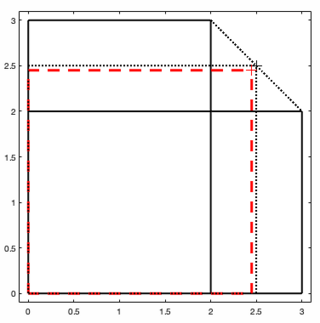Conversion of units is the conversion between different units of measurement for the same quantity, typically through multiplicative conversion factors which change the measured quantity value without changing its effects. Unit conversion is often easier within the metric or the SI than in others, due to the regular 10-base in all units and the prefixes that increase or decrease by 3 powers of 10 at a time.

In mathematics, a square root of a number x is a number y such that ; in other words, a number y whose square is x. For example, 4 and −4 are square roots of 16 because .
In mathematics, a continued fraction is an expression obtained through an iterative process of representing a number as the sum of its integer part and the reciprocal of another number, then writing this other number as the sum of its integer part and another reciprocal, and so on. In a finite continued fraction, the iteration/recursion is terminated after finitely many steps by using an integer in lieu of another continued fraction. In contrast, an infinite continued fraction is an infinite expression. In either case, all integers in the sequence, other than the first, must be positive. The integers are called the coefficients or terms of the continued fraction.
In mathematics, taking the nth root is an operation involving two numbers, the radicand and the index or degree. Taking the nth root is written as , where x is the radicand and n is the index. This is pronounced as "the nth root of x". The definition then of an nth root of a number x is a number r which, when raised to the power of the positive integer n, yields x:
In algebra, the partial fraction decomposition or partial fraction expansion of a rational fraction is an operation that consists of expressing the fraction as a sum of a polynomial and one or several fractions with a simpler denominator.

In mathematics, a cube root of a number x is a number y such that y3 = x. All nonzero real numbers have exactly one real cube root and a pair of complex conjugate cube roots, and all nonzero complex numbers have three distinct complex cube roots. For example, the real cube root of 8, denoted , is 2, because 23 = 8, while the other cube roots of 8 are and . The three cube roots of −27i are
In mathematics, a quadratic irrational number is an irrational number that is the solution to some quadratic equation with rational coefficients which is irreducible over the rational numbers. Since fractions in the coefficients of a quadratic equation can be cleared by multiplying both sides by their least common denominator, a quadratic irrational is an irrational root of some quadratic equation with integer coefficients. The quadratic irrational numbers, a subset of the complex numbers, are algebraic numbers of degree 2, and can therefore be expressed as

The square root of 2 is a positive real number that, when multiplied by itself, equals the number 2. It may be written in mathematics as or . It is an algebraic number, and therefore not a transcendental number. Technically, it should be called the principal square root of 2, to distinguish it from the negative number with the same property.
In mathematics, a rational function is any function that can be defined by a rational fraction, which is an algebraic fraction such that both the numerator and the denominator are polynomials. The coefficients of the polynomials need not be rational numbers; they may be taken in any field K. In this case, one speaks of a rational function and a rational fraction over K. The values of the variables may be taken in any field L containing K. Then the domain of the function is the set of the values of the variables for which the denominator is not zero, and the codomain is L.
In complex analysis, a branch of mathematics, a generalized continued fraction is a generalization of regular continued fractions in canonical form, in which the partial numerators and partial denominators can assume arbitrary complex values.
In mathematics, the difference of two squares is a squared number subtracted from another squared number. Every difference of squares may be factored according to the identity

A fraction represents a part of a whole or, more generally, any number of equal parts. When spoken in everyday English, a fraction describes how many parts of a certain size there are, for example, one-half, eight-fifths, three-quarters. A common, vulgar, or simple fraction consists of an integer numerator, displayed above a line, and a non-zero integer denominator, displayed below that line. If these integers are positive, then the numerator represents a number of equal parts, and the denominator indicates how many of those parts make up a unit or a whole. For example, in the fraction 3/4, the numerator 3 indicates that the fraction represents 3 equal parts, and the denominator 4 indicates that 4 parts make up a whole. The picture to the right illustrates 3/4 of a cake.
Methods of computing square roots are algorithms for approximating the non-negative square root of a positive real number . Since all square roots of natural numbers, other than of perfect squares, are irrational, square roots can usually only be computed to some finite precision: these methods typically construct a series of increasingly accurate approximations.
In mathematics, the conjugate of an expression of the form is provided that does not appear in a and b. One says also that the two expressions are conjugate.
In algebra, an algebraic fraction is a fraction whose numerator and denominator are algebraic expressions. Two examples of algebraic fractions are and . Algebraic fractions are subject to the same laws as arithmetic fractions.

The square root of 3 is the positive real number that, when multiplied by itself, gives the number 3. It is denoted mathematically as or . It is more precisely called the principal square root of 3 to distinguish it from the negative number with the same property. The square root of 3 is an irrational number. It is also known as Theodorus' constant, after Theodorus of Cyrene, who proved its irrationality.
In mathematics, an infinite periodic continued fraction is a continued fraction that can be placed in the form
The square root of 5 is the positive real number that, when multiplied by itself, gives the prime number 5. It is more precisely called the principal square root of 5, to distinguish it from the negative number with the same property. This number appears in the fractional expression for the golden ratio. It can be denoted in surd form as:

In mathematics, the values of the trigonometric functions can be expressed approximately, as in , or exactly, as in . While trigonometric tables contain many approximate values, the exact values for certain angles can be expressed by a combination of arithmetic operations and square roots.

The square root of 6 is the positive real number that, when multiplied by itself, gives the natural number 6. It is more precisely called the principal square root of 6, to distinguish it from the negative number with the same property. This number appears in numerous geometric and number-theoretic contexts. It can be denoted in surd form as:
This material is carried in classic algebra texts. For example:



































